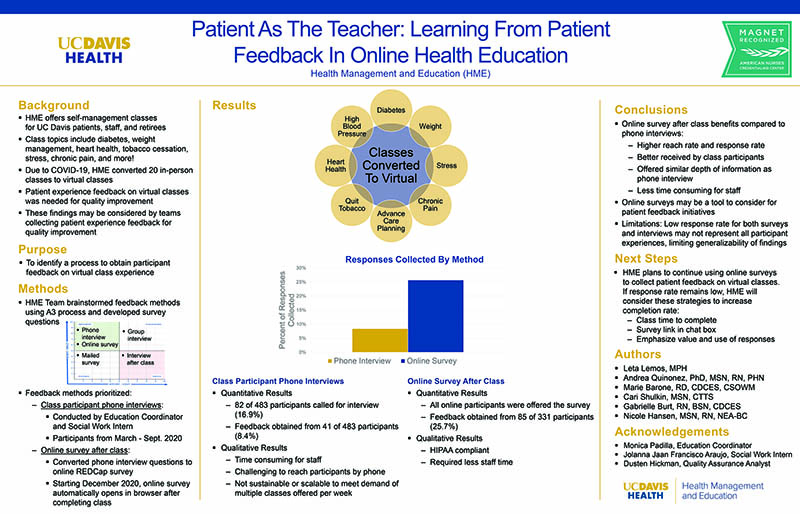
Hover to pan and click to magnify. Click again to pan at full screen.
Leta Lemos, MPH, Health Educator
Andrea Quinonez, PhD, MSN, RN, PHN, QI Healthcare Specialist
Marie Barone, RD, CDCES, CSOWM, Registered Dietitian
Cari Shulkin, MSN, CTTS, Certified Cardiac-Vascular Nurse
Gabrielle Burt, RN, BSN, CDCES, CNIII/Diabetes Education
Nicole Hansen, MSN, RN, NEA-BC, Manager
Leta Lemos, MPH, Health Educator
Andrea Quinonez, PhD, MSN, RN, PHN, QI Healthcare Specialist
Marie Barone, RD, CDCES, CSOWM, Registered Dietitian
Cari Shulkin, MSN, CTTS, Certified Cardiac-Vascular Nurse
Gabrielle Burt, RN, BSN, CDCES, CNIII/Diabetes Education
Nicole Hansen, MSN, RN, NEA-BC, Manager
UC Davis Health Health Management and Education
ABSTRACT
Title: Patient as the teacher: learning from patient feedback in online health education
Background
Health Management and Education (HME) provides classes for UC Davis Health patients, staff, and retirees on a variety of chronic disease self-management, health, and wellness topics. In response to COVID-19, HME converted classes to a virtual platform for continued access to high-quality, interactive health education. Providing synchronous, virtual patient group education was a novel approach for HME. Patient feedback about their online learning experience was needed to identify strengths and improvement opportunities. Various methods and tools were considered, with the goal of identifying a HIPAA compliant, secure, meaningful, and efficient method of data collection. These findings may be considered by other healthcare teams working to incorporate patient feedback into their quality improvement processes.
Purpose
The purpose of this project was to identify a process to obtain and evaluate patient feedback about their experience with the virtual health education class.
Methods
Team members included: two Registered Nurses, one Registered Dietitian, one Health Educator, one Education Coordinator and one Social Work Intern. The team brainstormed and prioritized methods for obtaining feedback using a PICK chart, in addition to determining survey questions. The first intervention was telephonic outreach by the Education Coordinator and Social Work Intern to class participants between March and September 2020. Patients were interviewed using a structured guide and data was logged in Excel. The second intervention was to modify the interview guide to an online survey via Research Electronic Data Capture (REDCap), a secure, web-based application designed to support data capture for research studies. As of December 2020, upon completing an online class, participants are automatically invited to complete the REDCap survey. Data are managed in REDCap and aggregate results are visualized in a Tableau dashboard.
Results
During telephonic outreach, feedback was obtained from 41 of 483 class participants (8.4%). Only 82 of 483 (16.9%) class participants were outreached to. This method was time consuming for staff and challenging to reach all patients by phone. As such, this workflow was not sustainable or scalable, as multiple classes are offered per week. The second intervention of an online REDCap survey had many benefits as a method including being HIPAA compliant, secure, and requiring less staff time. As of April 23, 2021, there have been 85 responses to the online survey via REDCap out of 331 participants (25.7%). All online participants are offered the survey.
Conclusions
Of the two methods used for obtaining patient feedback, the REDCap survey eased work burden to have an automated outreach approach and felt less intrusive by the staff while also offering a similar depth of information. Therefore, it may be a tool to consider for other patient feedback initiatives in which survey collection methods are most appropriate. Due to limited time of data collection at time of reporting, the current sample size is not large enough to perform thematic analysis or inform expected overall response rate. The team will explore strategies to continue to increase the response rate. The limitations of this project are the sample size.

DISQUS COMMENTS WILL BE SHOWN ONLY WHEN YOUR SITE IS ONLINE